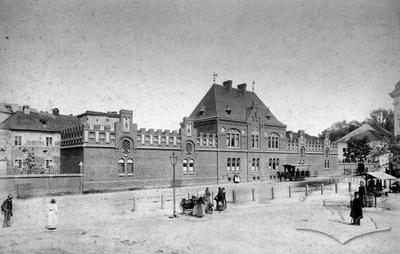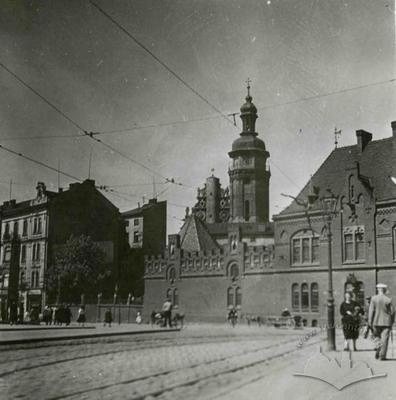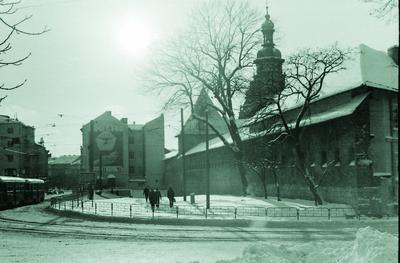Vul. Vynnychenka, 3 – residential building
This house was commissioned by Albertyna Lączyńska and built by Zygmunt Kędzierski on the site of a previous house in 1898-1899. It is one of the earliest examples of Historicism influenced by the aesthetics of Secession, erected with the use of reinforced concrete structures. The building is an architectural monument with the protection number 1650-M.
Architecture
A well-known tourist guidebook about Lviv once described this building as "a majestic townhouse in a new style" (Barański, 1904, 44). Around 1904, Secession style developed in the city, designed to become a new architecture, one that would move academicism in architecture (Historicism style) from the forefront. According to researchers Yuliya Bohdanova and Żanna Komar, the creators of Secession in Lviv were mostly young architects (Secesja we Lwowie, 2015, 161-162). In contrast, the house on vul. Vynnychenka reflects the approach that is characteristic of the then older generation of architects. The author of the project, Zygmunt Kędzierski (b. 1839), was one of them. His projects, and not only that implemented at vul. Vynnychenka 3, combine the use of the latest materials and structures of that time as well as engineering networks with traditional, historicizing aesthetics. The building on vul. Vynnychenka is neo-baroque in its style, the splendor of its façades and interiors reflecting the wealth of its aristocratic owners who commissioned the project.
The ground floor was originally intended to house shops and other establishments, so part of its openings were large shop-windows. On the second or third floor, there are bay windows designed to improve the natural lighting of the apartments. This house is one of the earliest examples in Lviv, where they appeared, as bay windows became common in Lviv’s Secession townhouses beginning from the mid-1900s.
The façade is symmetrical except for the location of the main entrance. It is flanked by two thin protruded wall sections at the edges, which were topped with attics (which have virtually not been preserved); the third and sixth axes of the façade have two-story bay windows topped with balconies having rich wrought iron fences. The ground floor is separated by a cornice; the walls have banded rustication on the ground floor and are smooth above, the windows have profiled trimmings and wavy neo-baroque pediments. The side wall facing the fire station was left blind, with textured recessed panels of neo-baroque shape. As can be seen from the photos, even in the interwar period it was used for advertising. In the Soviet times, visual propaganda was placed there, replaced by advertising banners today.
Related Places
Personalities
Winiarz (Ignacy Winiarz) — architect who designed an additional wing to the Neoclassical house which was never built
Adolf Wittmann — architect who designed the interior of Fryderyka Landau's shop in 1928
Frydryk Karge — a master tailor who owned a shop in the Neoclassical house
Zygmunt Kędzierski (1839–1924) — architect, who designed the present building
Regina Laсmann — owner of the Rezeda fashion salon in the house in the 1930s
Fryderyka Landau — owner of a clothing shop in the house in the 1920s
Władysław Łoziński (1843–1913) — historian of arts who headed the Circle of Conservators of Ancient Monuments in Eastern Galicia in the 1890s, and was the Conservator for the district of Lviv
Izydor Łączyński — count who owned the house from 1898 till 1900s, he was a landowner in Hole Rawskie (today, Ravske village in Zhovkva district), in 1897 he lived in Lviv at 18 Chorążczyzna street (today, vul. Chaykovskoho)
Daniel Magoński — vicar of the Bernardine monastery in 1898
Stanisław Markiewicz — director of the Association of Traders and Trade Youth, which was the owner of the neighboring building (Vynnychenka, 1) in 1898
Szymon Niemczycki — abbot of the Bernardine monastery in 1898
Joanna Platowska — coowner of the house in 1916
Karolina Platowska — Stanisław Platowski's wife, coowner of the house before 1939
Stanisław Platowski — coowner of the building before 1931, a member of the City Council
Leon Porter — designer of the Rezeda shop sign
Eugeniusz Radecki (~1825–1892) — administrator of the real estate (1872) in the absence of Stanisław and Anna Rodkiewicz
Anna and Stanisław Rodkiewicz — owners of the previous house before 1877
Jan Rodkiewicz (Johann Ritter von Rodkiewicz) — father of Stanisław, he built the previous house here in the 1830s or early 1840s
Sabin Signio — curator of the Bernardine monastery in 1898
Feliks Signio — building contractor who designed the sewers for the neigboring building no. 1
Stanislawa Skarbek (Stanisława Anna Katarzyna Skarbek née Witwicka) — countess, owner of the previous house in 1877–1892 роках
Tadeusz Sołowij (1857–1912) — lawyer who assisted the Łączyńskis on the matters of the house's construction in 1898-1899 роках
Aleksander Czołowski (1865–1944) — historian, у 1898 — secretary of the Circle of Conservators, its full-fledged member from 1899, director of the City Archive
Lusia Schafel — owner of the Rezeda fashion salon in the house
Sources
2. DALO2/2/3446
3. Księga adresowa królewskiego stołecznego miasta Lwowa (Lwów, 1897)
4. Księga adresowa królewskiego stołecznego miasta Lwowa (Lwów, 1900)
5. Księga adresowa królewskiego stołecznego miasta Lwowa (Lwów, 1901)
6. Księga adresowa królewskiego stołecznego miasta Lwowa (Lwów, 1902)
7. Księga adresowa królewskiego stołecznego miasta Lwowa (Lwów, 1913)
8. Księga adresowa królewskiego stołecznego miasta Lwowa (Lwów, 1916)
9. Przewodnik po Lwowie ułożył Fr. Barański (Lwów, 1904)
10. Schematismus fur die Königreiche Galizien und Lodomerien, sammt einem Namen-Register für das Jahr 1806-1808, 1812-1818, 1822-1828, 1830-1833, 1835-1839, 1841, 1843-1854
11. Skorowidz królewskiego stołecznego miasta Lwowa (Lemberg, 1872)
12. Skorowidz królewskiego stołecznego miasta Lwowa (Lemberg, 1889)
13. Skorowidz królewskiego stołecznego miasta Lwowa (Lwów, 1910)
14. Skorowidz królewskiego stołecznego miasta Lwowa (Lwów, 1916)
15. "Kronika czynności", Teka konserwatorska. Rocznik II. Koła c.k. konserwatorów starożytnych pomników Galicyi Wschodniej, (Lwów, 1900)
16. Wegweiser der Kön. Haupstadt Lemberg (Lemberg, 1863)
17. Wielka księga adresowa Stoł. król. miasta Krakowa, Stoł. król. miasta Lwowa, Stoł. woln. Miasta Podgórza (Kraków, 1908)
18. Wielka księga adresowa Stoł. król. miasta Krakowa, Stoł. król. miasta Lwowa, Stoł. woln. Miasta Podgórza (Kraków, 1909)
19. "Kronika", Dodatek do Kurjera Lwowskiego, 1898, Nr. 114, 2
20. "Rada miasta Lwowa", Kurjer Lwowski, 1898, Nr. 181, 5
21. "Rada m. Lwowa", Kurjer Lwowski, 1898, Nr. 195, s. 4
22. "Wykaz sprzedanych we Lwowie realności w czerwcu 1898", Kurjer Lwowski, 1898, Nr. 202, 7
23. Julia Bohdanova, Żanna Komar, Secesja we Lwowie, (Kraków, 2014), 240
24. Ілько Лемко, Володимир Михалик, Георгій Бегляров, 1234 вулиці Львова, (Львів: Апріорі, 2009), 526
Media Archive Materials
Related Pictures

















